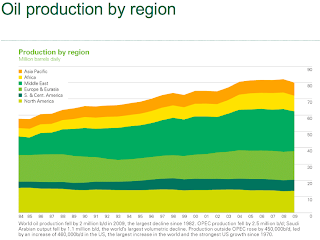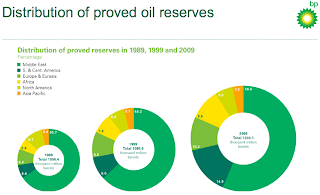
 Remember the WikiLeaks cables? You’d hardly know that they are still being released, but there are still some interesting Department of State cables appearing in the public domain.
Remember the WikiLeaks cables? You’d hardly know that they are still being released, but there are still some interesting Department of State cables appearing in the public domain.On February 8th, the Guardian released a WikiLeaks confidential cable from the Embassy in Riyadh after Consul General John Kincannon met with Dr. Sadad al-Husseini, the former Executive Vice President for Exploration and Production at Saudi Aramaco, Saudi Arabia’s oil production and exploration company. The two men met on November 20th, 2007, just prior to the massive increase in the price of oil that the world’s oil markets experienced in 2008.
Here’s what Dr. al-Husseini had to say in discussion with the Consul General:
“It is al-Husseini’s belief that while Aramco can reach 12 million b/d within the next 10 years, it will be unable to meet the goal of 12.5 million b/d by 2009. The former EVP added that sustaining 12 million b/d output will only be possible for a limited period of time, and even then, only with a massive investment program.
According to al-Husseini, the crux of the issue is twofold. First, it is possible that Saudi reserves are not as bountiful as sometimes described and the timeline for their production not as unrestrained as Aramco executives and energy optimists would like to portray. In a December 1 presentation at an Aramco Drilling Symposium, Abdallah al-Saif, current Aramco Senior Vice President for Exploration and Production, reported that Aramco has 716 billion barrels (bbls) of total reserves, of which 51 percent are recoverable. He then offered the promising forecast – based on historical trends – that in 20 years, Aramco will have over 900 billion barrels of total reserves, and future technology will allow for 70 percent recovery.
Al-Husseini disagrees with this analysis, as he believes that Aramco’s reserves are overstated by as much as 300 billion bbls of "speculative resources." He instead focuses on original proven reserves, oil that has already been produced or which is available for exploitation based on current technology. All parties estimate this amount to be approximately 360 billion bbls. In al-Husseini’s view, once 50 percent depletion of original proven reserves has been reached and the 180 billion bbls threshold crossed, a slow but steady output decline will ensue and no amount of effort will be able to stop it. By al-Husseini’s calculations, approximately 116 billion barrels of oil have been produced by Saudi Arabia, meaning only 64 billion barrels remain before reaching this crucial point of inflection. At 12 million b/d production, this inflection point will arrive in 14 years. Thus, while Aramco will likely be able to surpass 12 million b/d in the next decade, soon after reaching that threshold the company will have to expend maximum effort to simply fend off impending output declines. Al-Husseini believes that what will result is a plateau in total output that will last approximately 15 years, followed by decreasing output.
Al-Husseini elaborated that oil field depletion rates also play a significant role in determining the Aramco – and global – production timeline. Increasing output is not simply a function of adding new capacity to already existing operations. Instead, due to depletion rates, new reserves must be brought online to both replace depleted production and satisfy growth in consumption. The International Energy Agency (IEA) has estimated global depletion rates at 4 percent, while a 2006 Aramco statement has estimated Saudi Arabia’s overall depletion rate at 2 percent. Al-Husseini estimates that moving forward, satisfying increases in global demand will require bringing online annually at least 6 million b/d of worldwide output, 2 million to satisfy increased demand and 4 million to compensate for declining production in existing fields…
…Considering the rapidly growing global demand for energy – led by China, India and internal growth in oil-exporting countries – and in light of the above mentioned constraints on expanding current capacity, al-Husseini believes that the recent oil price increases are not market distortions but instead reflect the underlying reality that demand has met supply (global energy supply having remained relatively stagnant over the past years at approximately 85 million barrels/day). He estimates that the current floor price of oil, removing all geopolitical instability and financial speculation, is approximately 70 – 75 USD/barrel. Due to the longer-term constraints on expanding global output, al-Husseini judges that demand will continue to outpace supply and that for every million b/d shortfall that exists between demand and supply, the floor price of oil will increase 12 USD. Al-Husseini added that new oil discoveries are insufficient relative to the decline of the super-fields, such as Ghawar, that have long been the lynchpin of the global market.
While al-Husseini believes that Saudi officials overstate capabilities in the interest of spurring foreign investment, he is also critical of international expectations. He stated that the IEA’s expectation that Saudi Arabia and the Middle East will lead the market in reaching global output levels of over 100 million barrels/day is unrealistic, and it is incumbent upon political leaders to begin understanding and preparing for this "inconvenient truth." Al-Husseini was clear to add that he does not view himself as part of the "peak oil camp," and does not agree with analysts such as Matthew Simmons. He considers himself optimistic about the future of energy, but pragmatic with regards to what resources are available and what level of production is possible. While he fundamentally contradicts the Aramco company line, al-Husseini is no doomsday theorist. His pedigree, experience and outlook demand that his predictions be thoughtfully considered.” (my bold)
As a geoscientist, this is probably the most interesting Department of State cable that I have seen to date. If Dr. al-Husseini is indeed correct and his impressions are accurate, this information will ultimately have a massive impact on the world’s oil markets.
Perhaps BP’s Statistical Review of World Energy has shown us this graphically for several years. Here’s a graph showing basically flat production from the Middle East over the past 10 years and, by the way, Saudi Arabia’s oil production peaked at 11.114 million BOPD in 2005 and was 9.7 million BOPD in 2009:
Here are a set of graphs showing that the Middle East’s portion of the world’s proven oil reserves have not risen (and, in fact have dropped by 8 percent) over the past 20 years:
As the world’s historical swing producer, Saudi Arabia has always been there for consumers around the world when more oil is needed and their actions have lulled many of the world’s leaders into a false sense of security when it comes to their supply of energy. Perhaps Saudi Arabia has come to our rescue for the last time.
Click HERE to read more of Glen Asher’s columns.
Article viewed at: Oye! Times at www.oyetimes.com
You can publish this article on your website as long as you provide a link back to this page.



Be the first to comment